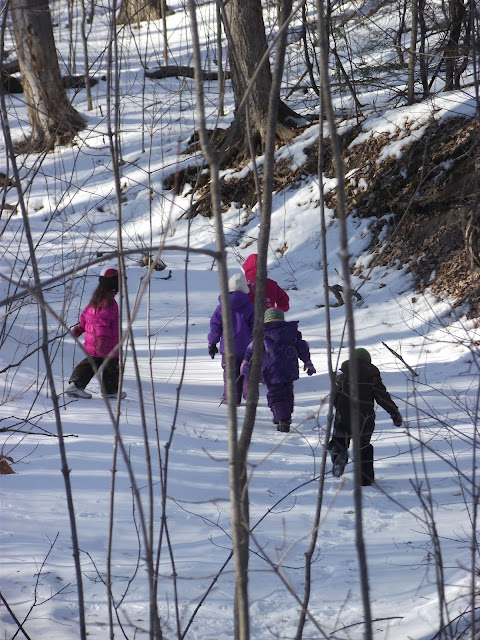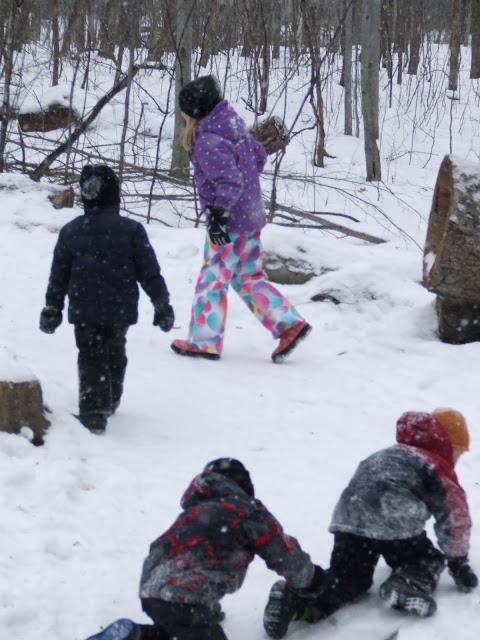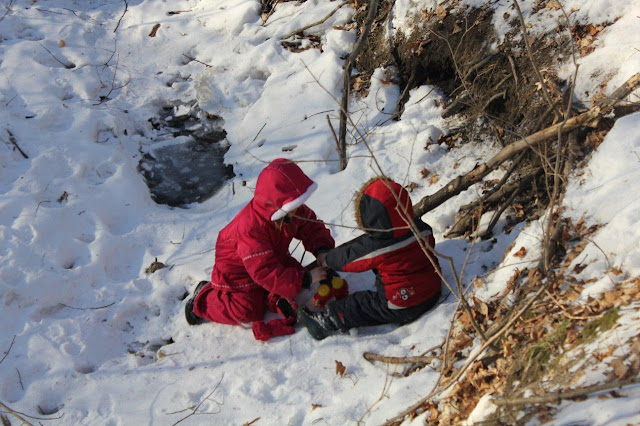Winter is almost here! Soon we can be certain that all of the precipitation that falls will be snow (yay!) and temperatures will not only be below freezing, but possibly very cold. Along with the cold comes the need to pay special attention to how children, adults, and families who will be spending a significant amount of time out on the land are dressed. As the temperature drops, being wet and cold is no longer simply a matter of possible discomfort, but also becomes a safety issue.

Through my years of working with groups, families, and children, I’ve learned that folks come to the winter from a great range of experiences. Some folks grew up loving winter, some grew up just bearing it until it ended, some didn’t grow up in winter at all. Adults, parents, and educators find it helpful to be given a detailed list of what clothing is needed, how to source it, and how to use it.
The following is a copy of a letter that I might share with participants to help them feel prepared for winter Forest and Nature School-inspired programs out on the land. We have heard that although families are ready for the cold, this type of letter helps them feel more prepared and less concerned about their own or their child’s warmth on a brisk, winter day. Perhaps you will find it helpful, too, in the work and play that you do on the land.
* * * * * * * * * *
This is the letter:
Here are some recommendations and tips to support your effort to help you and your child stay warm, dry and comfortable during your time with us in the wintery forest.
Please remember, even if the land at home is dry, the children will always find ways to get wet in the forest. The allure of puddles, mud, slush and snow is mighty (we feel it too!). We strongly encourage you to please have your child dressed for both wet and cold conditions when you drop them off.
Please know that we do not direct your children to get wet immediately, nor do we always make space for play to happen in particularly wet areas. We do strive to say yes, to support children in following their own interests and curiosity, to help children make informed, smart and kind choices, and to have the opportunity to learn from these choices. So, we will end up coming upon water as we explore and play on the land, and children will get wet.
Along with the clothes that your child is wearing, we strongly recommend that you send a bag of back-up/extra clothing.
Cotton clothing is very comfortable for most indoor settings, and is the least desirable choice for layers in the forest. Once cotton gets wet it stays wet and it loses all of its insulating properties. Please avoid cotton clothing for winter Forest School days.
There is a financial burden associated with being able to dress a child (or adult, for that matter!) well for cold weather play. Amassing quality gear can be a challenge in a number of ways. Canadian Tire tends to sell quality mitts, socks, boots and outerwear at a reasonable price. The Dollar Store regularly has quality socks and mitts at a good price. Grocery stores that sell clothing often have children’s base layers for reasonable prices. Children’s consignment and thrift shops tend to carry quality children’s outerwear and insulating layers that can be purchased for reasonable prices.
Labelling children’s items, including each article of winter gear, is extremely helpful for the staff team in helping to make sure each family gets back their own items each day. There are so many black neck warmers, black mitts, and black snowpants! It’s important to us that each child gets back their items, and labelling them is a way for us to help make that happen.

The following is the strategy that we most often recommend for dressing for the weather, and what we see families choosing most often.
Base Layer- Also known as long johns, this first layer of clothing goes directly against your child’s skin, and is most effective if it is polyester, wool or silk (anything except cotton, but cotton underpants are fine). These materials are able to wick sweat and moisture away from the body so help your child to stay dry. Flannel, fleece, and polyester pyjamas work well for this layer, too.
Insulating Layer- This layer goes right after the base layer, and tends to be puffy and thick for insulation. Fleece and wool pants and sweaters work well here. On cold days, more than one Insulating Layer may be required. This is the one layer where cotton can sneak in and help out, in the form of comfy sweatpants or hoodies, though we do still recommend fleece if possible.
Outerwear- This refers to insulated snow pants and jackets. It still might make sense to send an extra pair of splash pants in case snow pants get wet, and these can be used as a waterproof shell layer over their extra insulating layers. If possible, snow pants and splash pants should extend over the tops of boots to help keep water out.
Socks- Children in the forest are skilled at getting their feet wet 😉 2 extra pairs of socks each day would be ideal for keeping feet warm and dry. Wool is by far the best material for socks as they provide insulation even if they are wet. A good pair of wool or synthetic (polyester) blend socks is much warmer than multiple pairs of cotton socks.

Mitts- Children constantly use their hands to interact with the environment. Having insulated, waterproof or water-resistant mitts (the ones with hard shells) that come up over the edges of their sleeves are the most user-friendly and most likely to keep hands warm and dry (as well as are likely easiest for children to put on and take off independently). Thin fabric gloves, while a favourite of many children, are not effective to keep hands warm as they tend to get wet and cold quickly while a child is at play.
Boots- As the temperature gets colder, it is time to make the switch to winter boots, even if there isn’t much snow on the ground. Feet in rubber boots get so cold- even if they’re wearing wool socks. It is a warmer and safer choice to wear winter boots while there are still puddles in the forest than it is to keep wearing rubber boots until the forest is frozen and covered in snow.
Because most winter boots are not completely waterproof and children will still be drawn to puddles, we carry plastic bags to put inside boots to help keep socks dry even if boots get wet. Some families find it helpful to drop their child off already having a plastic bag layer inside boots, or to tuck 2 or more small plastic bags into their child’s backpack for later.
If you are purchasing new boots this season, consider sizing up to accommodate thicker socks.
Hats and Neck Warmers- Synthetic, fleece or wool neck tubes or balaclavas are great to not only keep your child’s neck warm, but also their cheeks and faces on windy days. Toques should also be wool, synthetic or fleece, and big enough to fit down over a child’s ears.
Scarves are not recommended at Forest School, please, due to the possibility of their interfering with play and possible safety concerns.

Organizing it All- Keeping track of this much clothing can feel challenging. Many families find it helpful to have a bag specifically for extra clothes (in addition to the backpack their child will carry that has their lunch and water bottle in it). Staff find this form of organization, one labeled backpack for food and water, one labeled bag for extra clothes, the easiest to keep organized, too.
To summarize the information above, the clothing we recommend that you pack as extra gear (labeled if possible) is:
1 or 2 extra pairs of waterproof mittens
1 or 2 extra pairs of wool socks
Extra base layer, top and bottom (if possible)
Extra insulating layer, top and bottom (if possible) An extra neck tube
An extra winter hat
Splash pants (or snow pants, if you happen to have them)
We hope this information will help you feel prepared and ready for your child to stay warm and cozy with us in the forest this winter. Thanks for taking the time to read. We appreciate it.
* * * * * * * * * *
The circumstances for each group that heads out onto the land are unique. Some days with some groups will feel quite easy and smooth to be out in the cold for an extended time. Others will feel like a revolving door of child after child getting wet or struggling with the cold and needing to take turns going in to warm up and check in, possibly to change.
We know this. We know that winter weather can feel (and be!) challenging, and that while there are steps we can all take to support the experience of children being outside for extended periods in the cold, we cannot guarantee that there is a way for all participants to sink in and forget the cold.

Our hope is that knowing we are all dressed as warmly as possible will make the process of getting out, staying out, and experiencing the magic that is the forest in winter, smoother and more fun.
Happy winter-ing!

